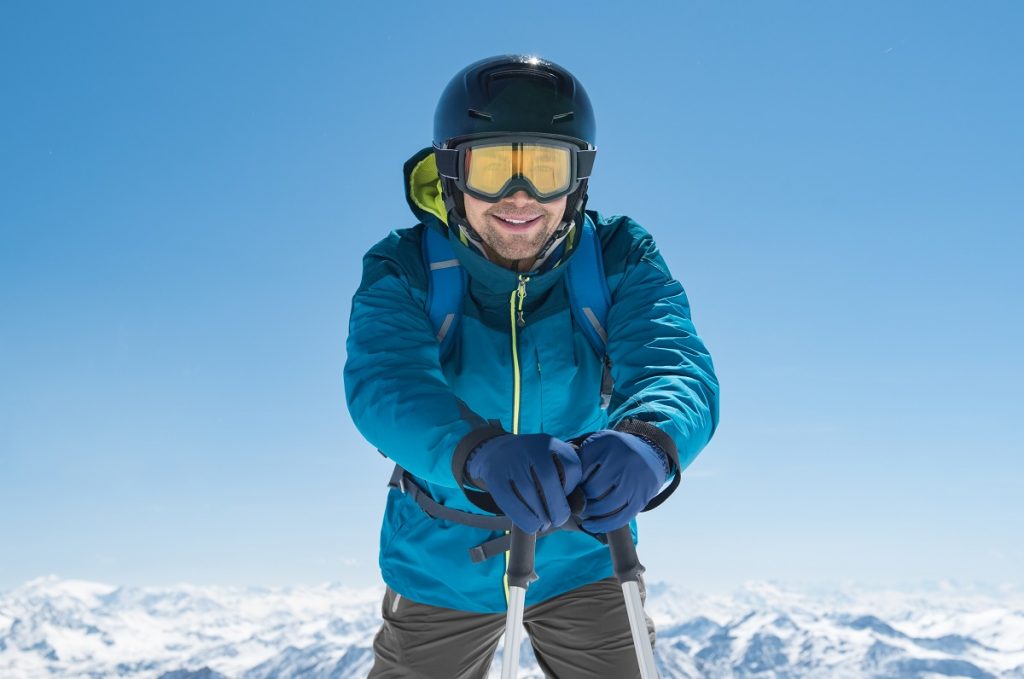Being out in the snow can be a fun, rewarding experience – if you’re wearing the right apparel. With the wrong clothes, you’ll become cold and miserable. Before you head out to those beautiful, snow-capped mountains, you should get clothes that not only look good and fit well, but also keep you warm, dry, safe, and comfortable.
Helmets
Annually, head injuries account for up to 20% of the 600,000 ski- and snowboarding-related injuries in North America. That is why it’s important to wear a helmet. It can make the difference between a simple fall and a trip to the hospital. Helmets should fit snugly and not move when you shake your head. You can buy one or rent one from your resort.
Goggles
Skiing is more fun when you can see where you’re going. The thinner atmosphere at higher altitudes filters less UV radiation which makes UV rays more intense. This can cause snow blindness, which is when UV rays bounce off the white snow and into your eyes. Avoid this condition by wearing goggles. Additionally, with goggles, you’ll get protection from snow and debris blowing in the air.
Base Layer
The layer closest to your body is important. It should insulate you while wicking away sweat so that you won’t end up cold. Your base layer should be made from a warm, moisture-wicking material such as Merino wool. Avoid wearing cotton as much as possible – a cotton base layer will stop your sweat from evaporating through your jacket and will leave you damp and clammy.
Mid Layer
This layer goes between your base layer and your ski jacket. Its main purpose is to keep you warm, throughout, the cold by trapping vital body heat. Mid layers range from tight-fitting synthetic fleeces to free-flowing inner jackets made of down. Much like the base layer, the mid layer needs to be breathable and comfortable.
Outer Layer
 Your outer layer should be made of ski jackets and pants that are water-resistant, breathable, and durable. If you’re eyeing an Obermeyer women’s ski jacket that’s on sale, make sure that it is comfortable and functional for both skiing and snowboarding. Additionally, ensure that your pants aren’t constricting and are waterproof.
Your outer layer should be made of ski jackets and pants that are water-resistant, breathable, and durable. If you’re eyeing an Obermeyer women’s ski jacket that’s on sale, make sure that it is comfortable and functional for both skiing and snowboarding. Additionally, ensure that your pants aren’t constricting and are waterproof.
Socks
Avoid cold feet by wearing good-quality ski socks made from synthetic material or wool. These should provide warmth and comfort. Ski socks are taller than regular socks which makes them perfect for ski boots. They should fit snugly so that they don’t bunch up inside your boot or cut off your circulation.
Gloves
Wearing gloves not only prolongs the fun but also protects your fingers from frostbite. Make sure you choose gloves that are waterproof and specially made for freezing temperatures.
It is important to make sure your clothes dry out overnight after each day in the snowy mountains. If your clothes are still damp from the day before, you will get cold much faster. If that happens, then your insulating layers will be useless.
When going out into the snow, you should always be prepared. Remember to dress for skiing success by wearing warm and water-resistant clothing that is not only fashionable but also functional.


